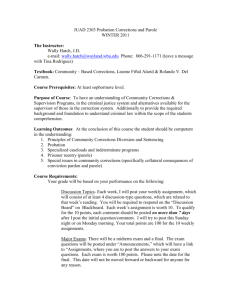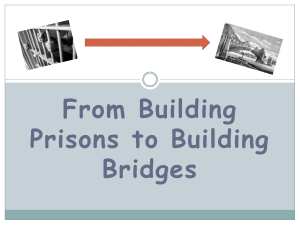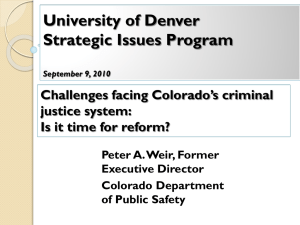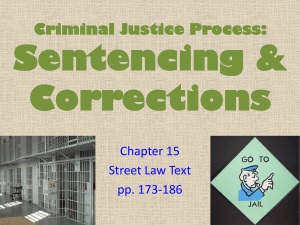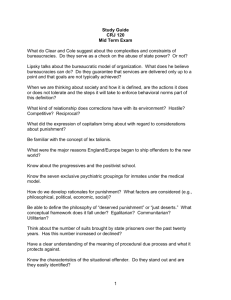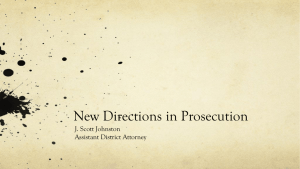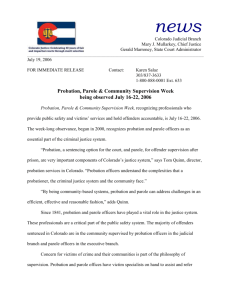Criminal Justice 101
advertisement
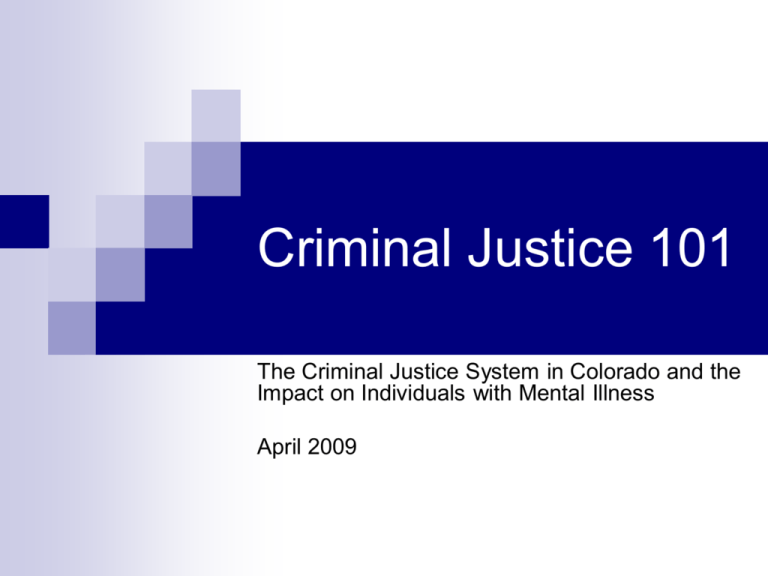
Criminal Justice 101 The Criminal Justice System in Colorado and the Impact on Individuals with Mental Illness April 2009 Acronyms DOC = Department of Corrections DYC = Division of Youth Corrections DCJ = Division of Criminal Justice DPS = Department of Public Safety YOS = Youth Offender System LSI = Level of Service Inventory DA = District Attorney (prosecutor) PD = Public Defender PED = Parole Eligibility Date ISP = Intensive Supervision (probation or parole) Why Do I Care? As mental health advocates and providers, the mass incarceration of individuals in Colorado is important for two reasons: 1) Morally—it is not the appropriate place for individuals suffering from mental illness. And, a criminal conviction has long lasting impacts on an individuals ability to obtain necessities such as housing and employment. 2) Fiscally—the amount of money spent incarcerating people in the prison system in Colorado is money that could be better spent on community treatment programs. Statistics According to the 2007 DOC Statistical Report. . . Nearly 30% of the inmates in Colorado prisons have a moderate to severe mental illness Approximately 82% have a moderate to severe substance abuse treatment need. 70% 60% Mental Health Need Levels in DOC Court Commitments 61.2% Mild to Severe Need Moderate to Severe Need 48.1% 50% 41.6% 40% 28.7% 30% 24.8% 19.9% 20% 10% 0% FY '04 FY '06 FY '07 Statistics Colorado’s prison population has increased more than 400% over the past 20 years. During the fiscal year (FY) ending June 30, 2007, Colorado’s average daily prison population was 22,424. This compares with an average daily prison population of 12,205 in FY 1997, and only 4,327 in FY 1987. In 2006, there were 469 state prisoners in Colorado for every 100,000 residents. That compares to a rate of 89 people per 100,000 residents in 1977. Colorado Prison Incarceration Rate Cost Comparisons Annual adult criminal justice placement costs in Colorado FY 2007 Regular probation $1,121 Intensive supervision probation $3,275 Residential Community Corrections $12,457 County Jails $22,000 Department of Corrections (DOC) $27,558 state facility $19,231 private prison facility Youthful Offender Center $68,818 San Carlos Psychiatric Facility $65,818 Colorado State Penitentiary $39,400 Denver Women’s Correctional Facility $33,445 Regular parole $3,401 Intensive supervision parole $8,319 Treating Mental Illness Vs. Sending People to Prison -Costs Per Person Per Year $70,000 $65,818 $60,000 $50,000 $40,000 $28,759 $30,000 $20,000 $10,000 $3,109 $FY '09 Community Mental Health FY '07 Colorado FY '07 Colorado Prison Average Prison Mental Health Facility Colorado Budget Constraints Colorado has both statutory and constitutional revenue and spending limits. These revenue and spending limits have created a situation where state spending on prisons has come at the expense of other state government services and programs. Colorado’s current budget short fall of nearly $1 billion dollars is an example of the dire fiscal situation facing the state—yet corrections spending has consistently been over the 6% limit placed on the general fund. Colorado Budget Constraints In 1991, the Colorado legislature passed the “Arveschoug-Bird” general fund appropriations limit, which statutorily holds state budget growth to 6%. In FY 2008, the DOC was 8.8% of the state budget. DOC and the Colorado Budget Criminal Justice 101 There is a separate adult and juvenile criminal justice system in Colorado. Understanding this complex system is important for mental health providers so we can better advocate for individuals in the system, and understand where interventions are possible. The Players The District Attorney Prosecutes crimes and investigates potential crimes on behalf of the people of Colorado. The Public Defender Provides representation for indigent individuals who are charged with a crime in Colorado. The right to counsel is established by both the United States and Colorado Constitutions. State AG and U.S. Attorneys In addition to the DA, the state attorney general (AG) and U.S. attorneys also prosecute cases in the state. The attorney general prosecutes and defends all suits relating to matters of state government. The attorney general is elected by the people and is a member of the governor’s cabinet. Federal prosecution is the responsibility of U.S. attorneys who are appointed by the president. District Attorneys (prosecutors) Prosecutors have been significant discretion in carrying out their responsibilities. They make many of the decisions that determine whether or not a case will proceed through the criminal justice process. District Attorneys (prosecutors) After the police arrest a person suspected to have committed a crime, the prosecutor coordinates the government’s response to the crime, including: the initial screening--when the prosecutor decides whether or not to press charges, the trial and, the sentencing, where in some instances, at the time of sentencing, by presenting sentencing recommendations. Sentencing The trial court has the following alternatives in imposing a sentence: probation; imprisonment for a defined period of time; a fine or; both a term of imprisonment and the payment of a fine Non-violent offenders may be sentenced to: probation, community corrections, home detention, or specialized restitution and community service. Jail v. Prison Yes there is a difference. . . County Jail Lawfully committed persons and prisoners are housed in a county jail for: detention, safekeeping, and confinement. Each county in the state is required to maintain a jail except counties with populations of less than 2,000. County Jail Offenders convicted of a misdemeanor offense are punishable by fine or imprisonment. A term of imprisonment for a misdemeanor is not served in a state correctional facility unless the sentence is served concurrently with a term of conviction for a felony. The court may also sentence an offender to: a term of jail and probation, to a term of jail and work release, or to a term of jail and a fine. State Prison Persons convicted of felony offenses are subject to a penalty of imprisonment. The length of the sentence is specified in statute corresponding to the felony class for which the offender was convicted. Colorado has both state and private prisons that house individuals confined for crimes that violate state law. Youthful Offender System (YOS) Certain juveniles tried and sentenced as adults may be sentenced to the YOS as an alternative to a sentence to prison. YOS was established in 1993 within the Colorado Department of Corrections to deal primarily with youth and violence. YOS is an option for certain youthful offenders to include a controlled and regimented environment with enriched programming. In order to sentence a juvenile to the YOS, the court must first impose a sentence to the DOC which is then suspended on the condition that the youthful offender completes a sentence to the YOS, including a period of community supervision. Federal Prison There are three federal prison facilities in Colorado—Denver, Florence and Englewood. Federal prisons are for individuals convicted of federal offenses. Community-Based Corrections Community-based corrections in Colorado include three basic categories: probationers, parolees, and offenders in community corrections facilities. Each of these community-based corrections is under the jurisdiction of a different branch of government: Probation - Judicial Department Parole - Department of Corrections Community Corrections - Department of Public Safety Probation The Colorado Judicial Department administers adult and juvenile probation within Colorado’s 22 judicial districts. Probation officers are involved in offender assessments, supervision, victim involvement and services to the community. Probation In considering whether to grant probation, the court may determine that prison is a more appropriate placement for the following reasons: there is an undue risk that the defendant will commit another crime while on probation; the defendant is in need of correctional treatment; a sentence to probation will unduly depreciate the seriousness of the defendant’s crime or undermine respect for law; past criminal record indicates that probation would fail to accomplish its intended purpose; or the crime and the surrounding factors do not justify probation. Probation Offenders are eligible for probation with the following exceptions: those convicted of a class 1 felony or class 2 petty offense; those who have been convicted of two prior felonies in Colorado or any other state; and those convicted of a class 1, 2 or 3 felony within the last ten years in Colorado or any other state. Eligibility restrictions may be waived by the sentencing court upon the recommendation of the DA. Parole Parole is a type of supervision after release from prison. Parolees are under the supervision of the Department of Corrections. Colorado statutes provide for both discretionary and mandatory parole periods. Mandatory parole, established in 1993, requires a parole period for all offenders released from prison. Discretionary parole occurs when the parole board makes the decision to parole an offender. Parole Violations In the event that a parolee violates the conditions of parole, the parolee may be arrested and required to appear at a hearing before the parole board or an administrative law judge. The board or administrative law judge determines guilt or innocence regarding the alleged parole violation. If the offender is found guilty, the board will impose sanctions (i.e. revoke parole, continue it in effect, or modify the conditions of parole). Parole Technical Violations When an individual is placed on parole, they are required to comply with the conditions of their parole, which could include certain individualized requirements such as: drug testing, mandatory treatment, not associating with certain people, job and housing requirements. If a person violates a condition of parole, it is considered a “technical violation.” Such technical violations can include: Testing positive for the use of drugs Not reporting to treatment Not checking in with the parole officer at specified times Associating with other felons Not getting a job or living in a prohibited location This is very different than being revoked for committing a new crime. Community Corrections Community-based programs help offenders, especially those released from prison, return successfully to the community. These programs provide the structure of a controlled living environment while the offender learns, or re-learns, the transportation system, acquires current identification, and becomes employed. Community Corrections Colorado’s community corrections system includes both public and private organizations of specific halfway house facilities that provide residential and non-residential services to convicted offenders. These programs provide an intermediate sanction at the front end of the system between probation and prison, and reintegration services at the end of the system between prison and parole. Community corrections placements allow offenders access to community resources, including treatment and employment opportunities, while living in a staff secure correctional setting. These facilities, often referred to as programs, receive state funds but are based and operated in local communities. Community Corrections Offenders can be referred to community corrections by the sentencing judge or by officials at the Department of Corrections (DOC). The judicial placement is considered a diversion from prison, and these cases are called “diversion clients.” The DOC placement of offenders in halfway houses serves as a method of transitioning prisoners back into the community and these cases are referred to as “transition clients.” Community Corrections Diversion clients are responsible to the probation department. Transition clients are under the jurisdiction of the DOC’s Division of Adult Parole and Community Corrections. Both diversion and transition clients are housed together and participate in programming together. Community Corrections Cases not approved by the board are returned to the judge or DOC for alternative placement. Programs also have the authority to refuse placement. Offenders in community corrections are expected to pay for much of their treatment in the community. In addition, offenders are expected to pay $17 per day for room and board, plus make other efforts to pay court costs, restitution, child support and other fines and fees. Community Corrections Boards Per statute, each jurisdiction has a community corrections board to screen offender referrals and to oversee the operation of the facilities. Board members typically consist of both criminal justice professionals and citizens. Diversion v. Transition Programs targeting individuals with mental health and co-occurring substance use needs have options to either work with diversion or transition clients. Diversion clients can include : probation, deferred sentences, diversion community corrections specialty courts Diversion v. Transition Working with individuals who are transitioning out of jail or prison is another option for mental health providers and mental health centers. Generally transition clients require more intensive service needs, which can include housing, vocational training, and training with daily living skills. What Works—Evidence-Based Principles for Effective Interventions 1. Assess Actuarial Risk/Needs. 2. Enhance Intrinsic Motivation. 3. Target Interventions. a. b. c. d. e. Risk Principle: Prioritize supervision and treatment resources for higher risk offenders. Need Principle: Target interventions to criminogenic needs. Responsivity Principle: Be responsive to temperament, learning style, motivation, culture, and gender when assigning programs. Dosage: Structure 40-70% of high-risk offenders’ time for 3-9 months. Treatment: Integrate treatment into the full sentence/sanction requirements. 4. Skill Train with Directed Practice (use Cognitive Behavioral treatment methods). 5. Increase Positive Reinforcement. 6. Engage Ongoing Support in Natural Communities. 7. Measure Relevant Processes/Practices. 8. Provide Measurement Feedback. MH/CJ Programs in Colorado There are several programs in Colorado developed in coordination with community partners and the community mental health centers. Examples include: JERP--(Jefferson Center for Mental Health)—Transition Program PACE--(Mental Health Center Serving Boulder and Broomfield Counties)— Diversion Program CESE --(Community Reach Center)—Diversion Program Court-to-Community--(Mental Health Center of Denver)—Diversion Program FOREST--(Aurora Mental Health Center)—Transition Program Policy and Legislation In 2007, legislation was passed, SB07097, creating the Offender Treatment Program for individuals suffering from mental health conditions. As a result of that funding source, there are currently 11 mental health centers with criminal justice programs. Sentencing Reform (2009) This legislative session, there will be legislation to reform the sentencing laws in Colorado. This legislation is critically important to begin to save money in the state and county budgets in the area of corrections. Additionally, it could potentially help divert people into treatment rather than incarceration. Next Steps Education Policy Mental health professionals and advocates must support and help develop sound policy around the treatment of individuals with mental health and substance use needs that are involved in the criminal justice system. Funding Mental health professionals and advocates must begin to educate the general public and policy makers about the importance of community-based treatment as an alternative to incarceration for individuals with mental health and substance use needs. More funding is necessary to help create alternatives to incarceration, provide for early treatment and intervention, as well as provide for the supports necessary to keep people successful in the community. Program Development Community Mental Health Centers, in collaboration with other partners at the state and local-level, can be leaders in the development of programs targeted at those individuals with mental illness that have been involved in the criminal justice system.
